Information System Management Report: TAM and BI Analysis
VerifiedAdded on 2022/08/18
|20
|5498
|11
Report
AI Summary
This report critically assesses the Technology Acceptance Model (TAM) developed by Davis, focusing on its application in information system management. It explores how users accept and utilize technology, emphasizing the role of behavioral intention (BI) and attitude (A). The report delves into the key factors of TAM, including perceived usefulness (PU) and perceived ease-of-use (PEOU), and how these influence user decisions. It provides examples to illustrate the concepts and discusses the impact of external variables like social influence. The report also highlights the model's evolution and its significance in predicting the acceptability of information systems. The report also explains the relationship between perceived ease of use, perceived usefulness, and the user's attitude, and how these factors ultimately influence the actual utilization of the system. The conclusion emphasizes the importance of promoting ease of use and influencing user intention to utilize new technologies. The report also looks at the factors that influence the user's intention to use the new technologies.
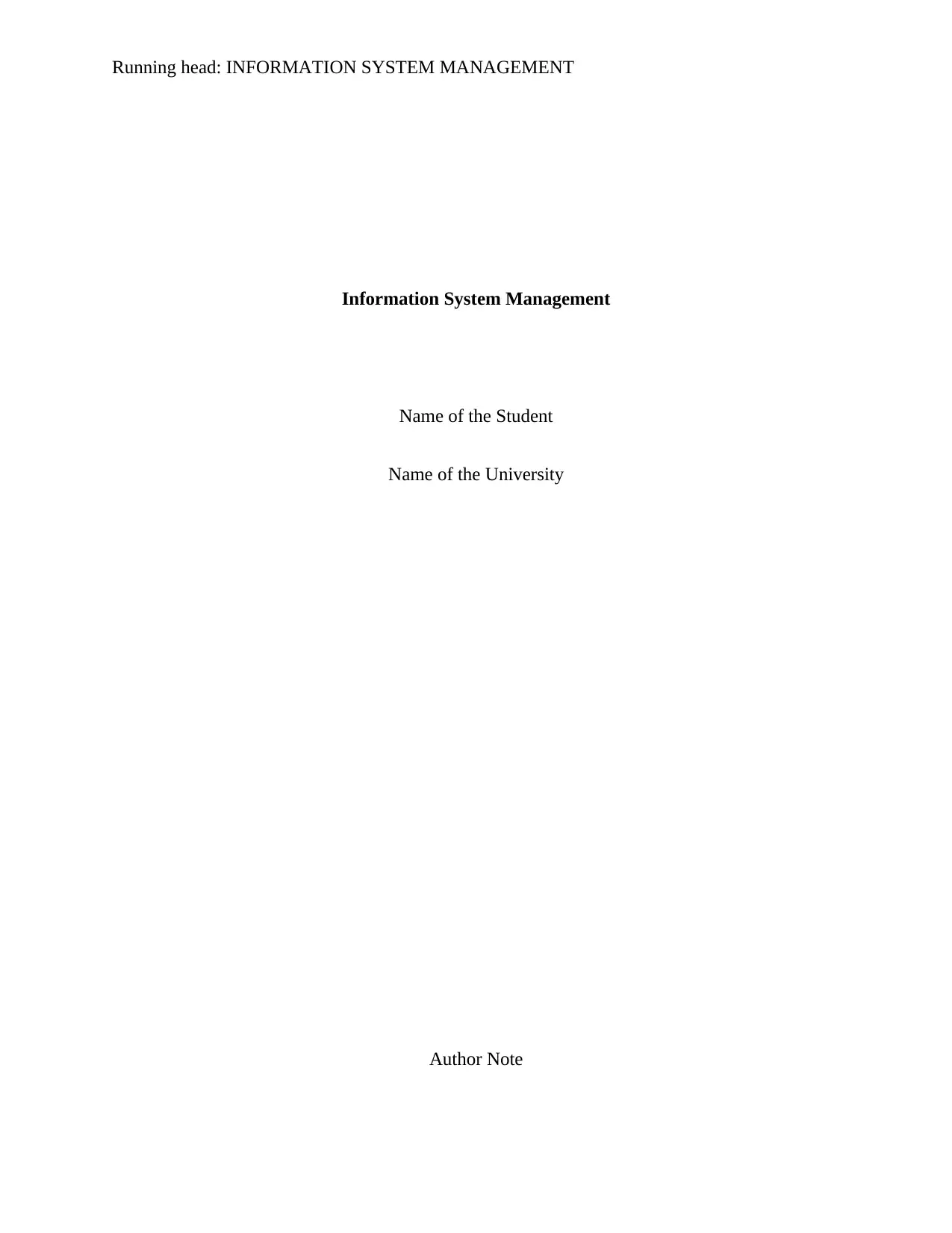
Running head: INFORMATION SYSTEM MANAGEMENT
Information System Management
Name of the Student
Name of the University
Author Note
Information System Management
Name of the Student
Name of the University
Author Note
Paraphrase This Document
Need a fresh take? Get an instant paraphrase of this document with our AI Paraphraser
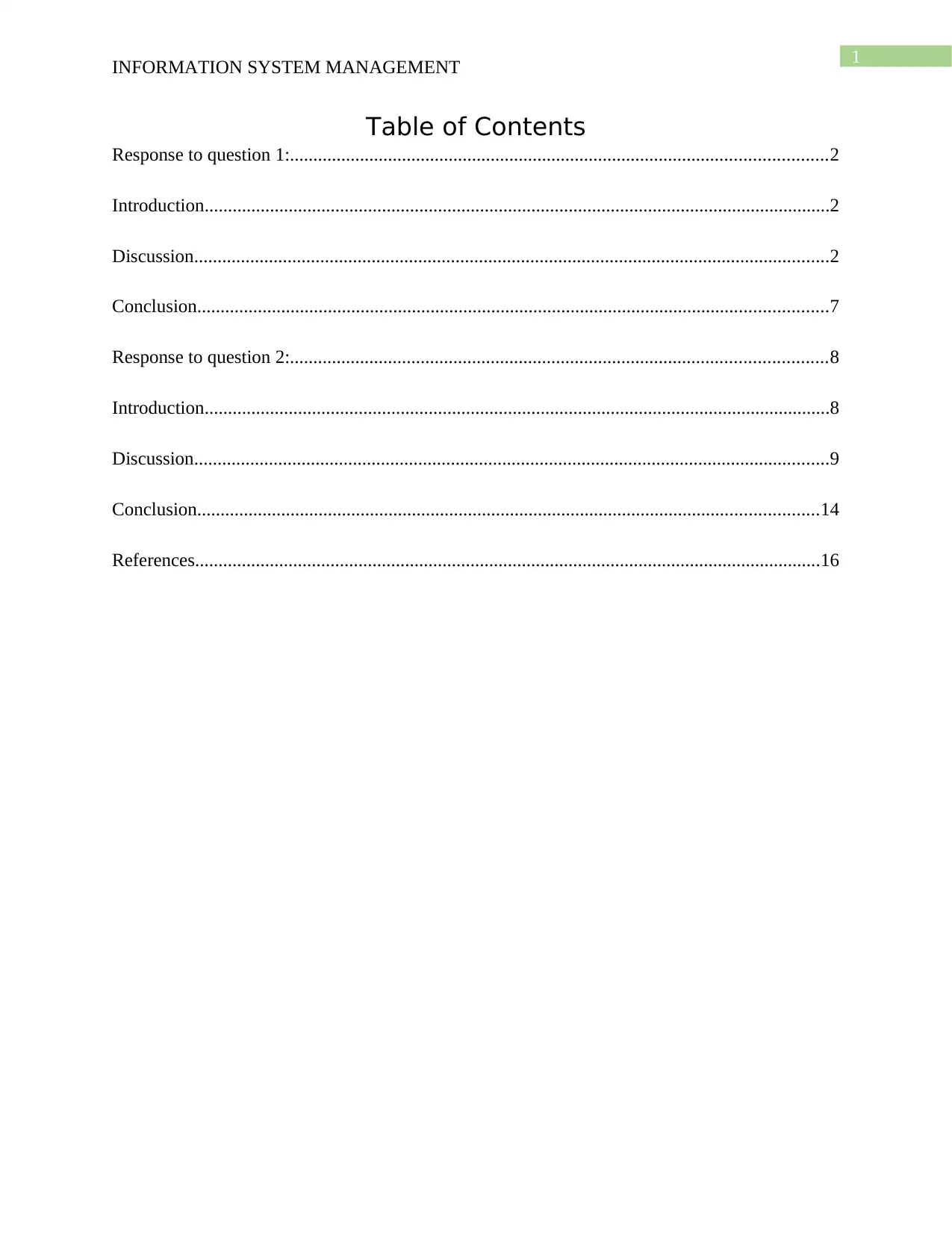
1
INFORMATION SYSTEM MANAGEMENT
Table of Contents
Response to question 1:...................................................................................................................2
Introduction......................................................................................................................................2
Discussion........................................................................................................................................2
Conclusion.......................................................................................................................................7
Response to question 2:...................................................................................................................8
Introduction......................................................................................................................................8
Discussion........................................................................................................................................9
Conclusion.....................................................................................................................................14
References......................................................................................................................................16
INFORMATION SYSTEM MANAGEMENT
Table of Contents
Response to question 1:...................................................................................................................2
Introduction......................................................................................................................................2
Discussion........................................................................................................................................2
Conclusion.......................................................................................................................................7
Response to question 2:...................................................................................................................8
Introduction......................................................................................................................................8
Discussion........................................................................................................................................9
Conclusion.....................................................................................................................................14
References......................................................................................................................................16
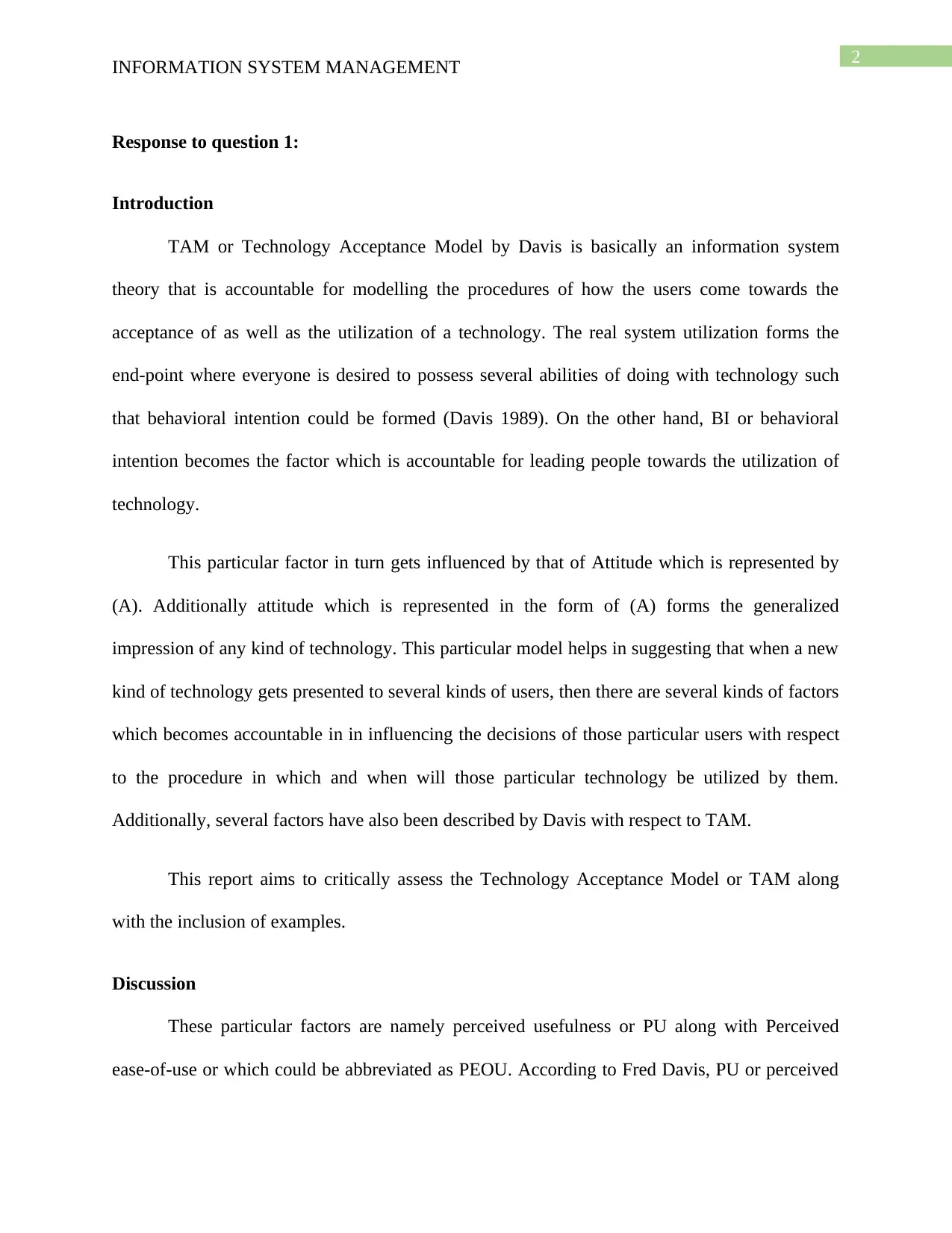
2
INFORMATION SYSTEM MANAGEMENT
Response to question 1:
Introduction
TAM or Technology Acceptance Model by Davis is basically an information system
theory that is accountable for modelling the procedures of how the users come towards the
acceptance of as well as the utilization of a technology. The real system utilization forms the
end-point where everyone is desired to possess several abilities of doing with technology such
that behavioral intention could be formed (Davis 1989). On the other hand, BI or behavioral
intention becomes the factor which is accountable for leading people towards the utilization of
technology.
This particular factor in turn gets influenced by that of Attitude which is represented by
(A). Additionally attitude which is represented in the form of (A) forms the generalized
impression of any kind of technology. This particular model helps in suggesting that when a new
kind of technology gets presented to several kinds of users, then there are several kinds of factors
which becomes accountable in in influencing the decisions of those particular users with respect
to the procedure in which and when will those particular technology be utilized by them.
Additionally, several factors have also been described by Davis with respect to TAM.
This report aims to critically assess the Technology Acceptance Model or TAM along
with the inclusion of examples.
Discussion
These particular factors are namely perceived usefulness or PU along with Perceived
ease-of-use or which could be abbreviated as PEOU. According to Fred Davis, PU or perceived
INFORMATION SYSTEM MANAGEMENT
Response to question 1:
Introduction
TAM or Technology Acceptance Model by Davis is basically an information system
theory that is accountable for modelling the procedures of how the users come towards the
acceptance of as well as the utilization of a technology. The real system utilization forms the
end-point where everyone is desired to possess several abilities of doing with technology such
that behavioral intention could be formed (Davis 1989). On the other hand, BI or behavioral
intention becomes the factor which is accountable for leading people towards the utilization of
technology.
This particular factor in turn gets influenced by that of Attitude which is represented by
(A). Additionally attitude which is represented in the form of (A) forms the generalized
impression of any kind of technology. This particular model helps in suggesting that when a new
kind of technology gets presented to several kinds of users, then there are several kinds of factors
which becomes accountable in in influencing the decisions of those particular users with respect
to the procedure in which and when will those particular technology be utilized by them.
Additionally, several factors have also been described by Davis with respect to TAM.
This report aims to critically assess the Technology Acceptance Model or TAM along
with the inclusion of examples.
Discussion
These particular factors are namely perceived usefulness or PU along with Perceived
ease-of-use or which could be abbreviated as PEOU. According to Fred Davis, PU or perceived
⊘ This is a preview!⊘
Do you want full access?
Subscribe today to unlock all pages.

Trusted by 1+ million students worldwide
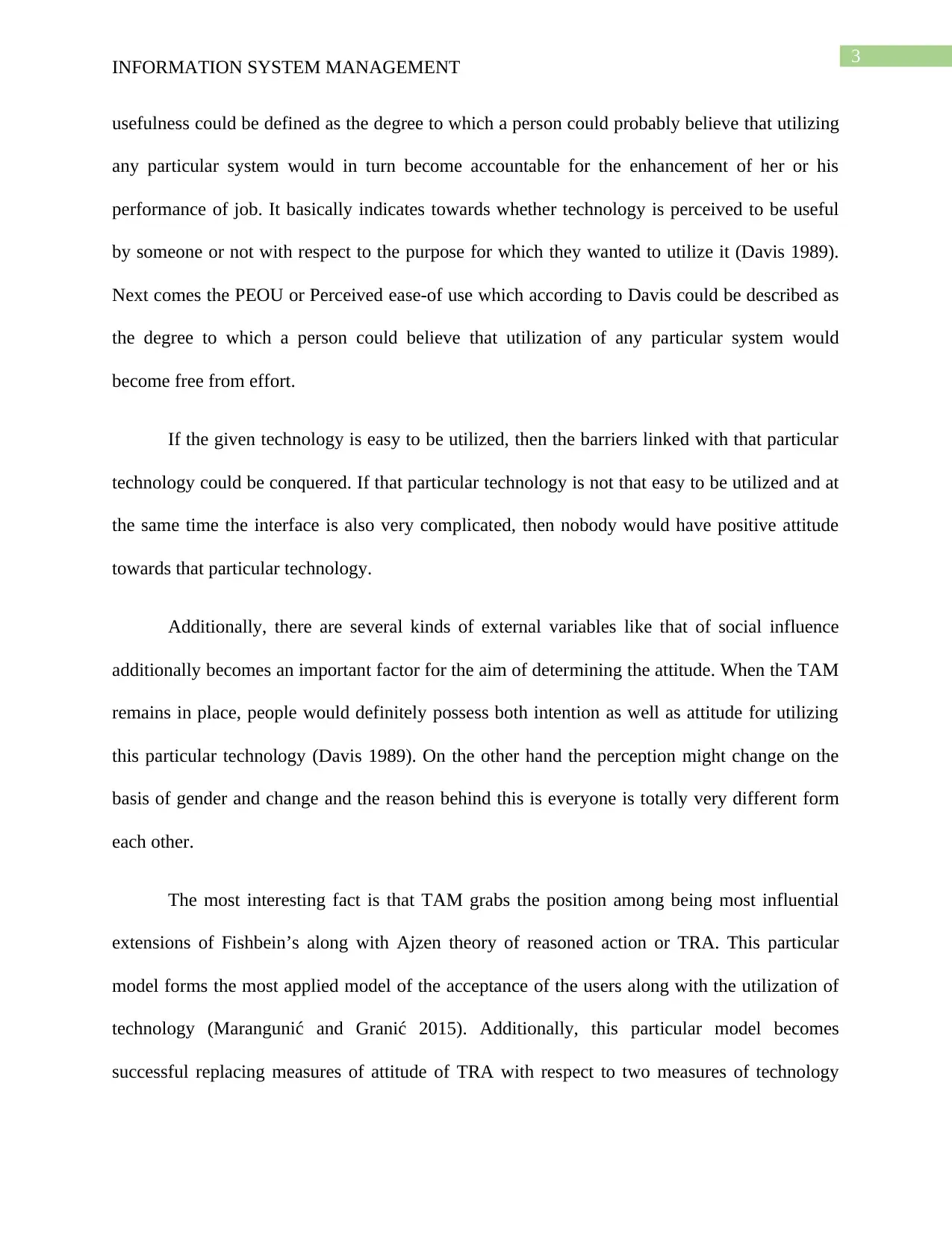
3
INFORMATION SYSTEM MANAGEMENT
usefulness could be defined as the degree to which a person could probably believe that utilizing
any particular system would in turn become accountable for the enhancement of her or his
performance of job. It basically indicates towards whether technology is perceived to be useful
by someone or not with respect to the purpose for which they wanted to utilize it (Davis 1989).
Next comes the PEOU or Perceived ease-of use which according to Davis could be described as
the degree to which a person could believe that utilization of any particular system would
become free from effort.
If the given technology is easy to be utilized, then the barriers linked with that particular
technology could be conquered. If that particular technology is not that easy to be utilized and at
the same time the interface is also very complicated, then nobody would have positive attitude
towards that particular technology.
Additionally, there are several kinds of external variables like that of social influence
additionally becomes an important factor for the aim of determining the attitude. When the TAM
remains in place, people would definitely possess both intention as well as attitude for utilizing
this particular technology (Davis 1989). On the other hand the perception might change on the
basis of gender and change and the reason behind this is everyone is totally very different form
each other.
The most interesting fact is that TAM grabs the position among being most influential
extensions of Fishbein’s along with Ajzen theory of reasoned action or TRA. This particular
model forms the most applied model of the acceptance of the users along with the utilization of
technology (Marangunić and Granić 2015). Additionally, this particular model becomes
successful replacing measures of attitude of TRA with respect to two measures of technology
INFORMATION SYSTEM MANAGEMENT
usefulness could be defined as the degree to which a person could probably believe that utilizing
any particular system would in turn become accountable for the enhancement of her or his
performance of job. It basically indicates towards whether technology is perceived to be useful
by someone or not with respect to the purpose for which they wanted to utilize it (Davis 1989).
Next comes the PEOU or Perceived ease-of use which according to Davis could be described as
the degree to which a person could believe that utilization of any particular system would
become free from effort.
If the given technology is easy to be utilized, then the barriers linked with that particular
technology could be conquered. If that particular technology is not that easy to be utilized and at
the same time the interface is also very complicated, then nobody would have positive attitude
towards that particular technology.
Additionally, there are several kinds of external variables like that of social influence
additionally becomes an important factor for the aim of determining the attitude. When the TAM
remains in place, people would definitely possess both intention as well as attitude for utilizing
this particular technology (Davis 1989). On the other hand the perception might change on the
basis of gender and change and the reason behind this is everyone is totally very different form
each other.
The most interesting fact is that TAM grabs the position among being most influential
extensions of Fishbein’s along with Ajzen theory of reasoned action or TRA. This particular
model forms the most applied model of the acceptance of the users along with the utilization of
technology (Marangunić and Granić 2015). Additionally, this particular model becomes
successful replacing measures of attitude of TRA with respect to two measures of technology
Paraphrase This Document
Need a fresh take? Get an instant paraphrase of this document with our AI Paraphraser
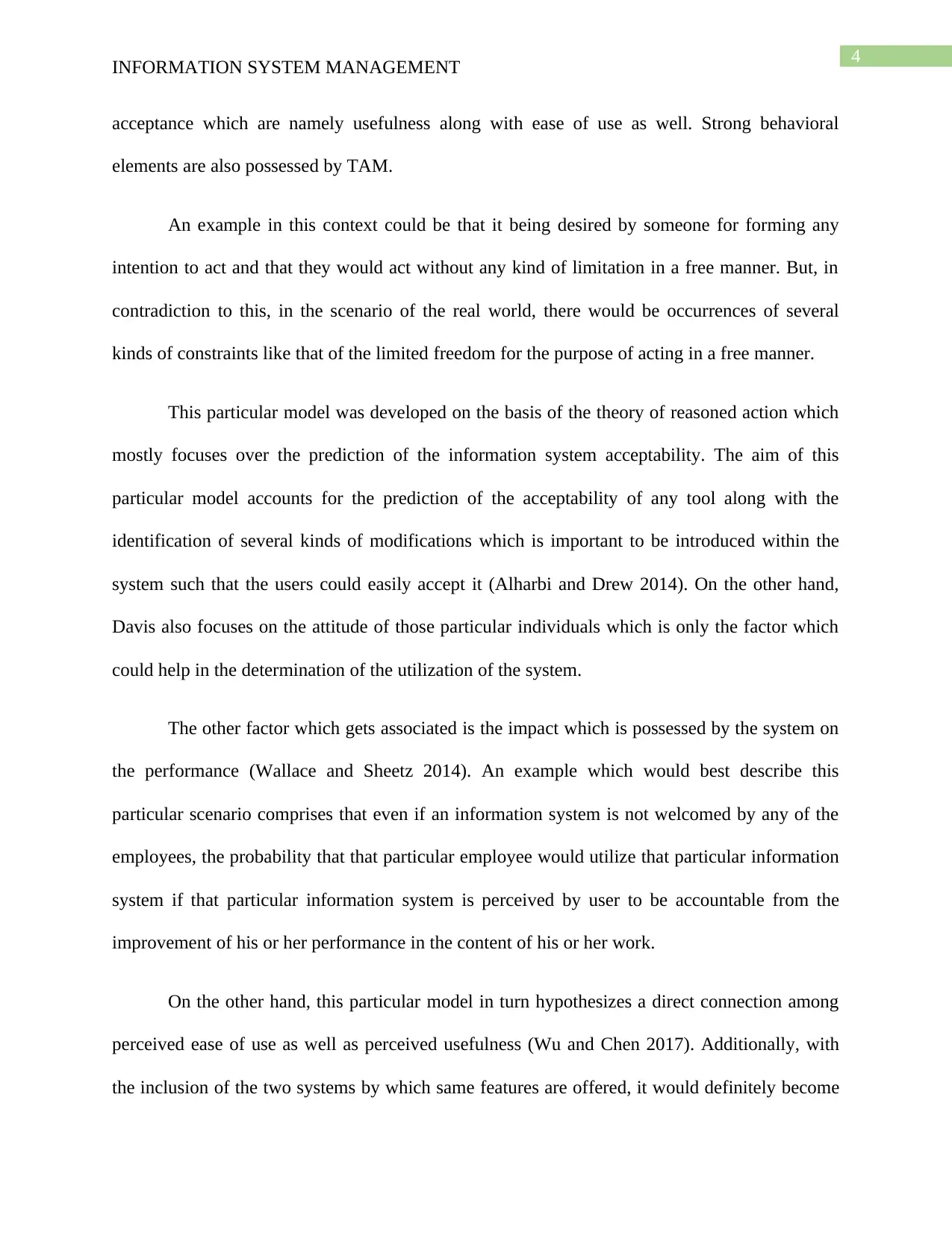
4
INFORMATION SYSTEM MANAGEMENT
acceptance which are namely usefulness along with ease of use as well. Strong behavioral
elements are also possessed by TAM.
An example in this context could be that it being desired by someone for forming any
intention to act and that they would act without any kind of limitation in a free manner. But, in
contradiction to this, in the scenario of the real world, there would be occurrences of several
kinds of constraints like that of the limited freedom for the purpose of acting in a free manner.
This particular model was developed on the basis of the theory of reasoned action which
mostly focuses over the prediction of the information system acceptability. The aim of this
particular model accounts for the prediction of the acceptability of any tool along with the
identification of several kinds of modifications which is important to be introduced within the
system such that the users could easily accept it (Alharbi and Drew 2014). On the other hand,
Davis also focuses on the attitude of those particular individuals which is only the factor which
could help in the determination of the utilization of the system.
The other factor which gets associated is the impact which is possessed by the system on
the performance (Wallace and Sheetz 2014). An example which would best describe this
particular scenario comprises that even if an information system is not welcomed by any of the
employees, the probability that that particular employee would utilize that particular information
system if that particular information system is perceived by user to be accountable from the
improvement of his or her performance in the content of his or her work.
On the other hand, this particular model in turn hypothesizes a direct connection among
perceived ease of use as well as perceived usefulness (Wu and Chen 2017). Additionally, with
the inclusion of the two systems by which same features are offered, it would definitely become
INFORMATION SYSTEM MANAGEMENT
acceptance which are namely usefulness along with ease of use as well. Strong behavioral
elements are also possessed by TAM.
An example in this context could be that it being desired by someone for forming any
intention to act and that they would act without any kind of limitation in a free manner. But, in
contradiction to this, in the scenario of the real world, there would be occurrences of several
kinds of constraints like that of the limited freedom for the purpose of acting in a free manner.
This particular model was developed on the basis of the theory of reasoned action which
mostly focuses over the prediction of the information system acceptability. The aim of this
particular model accounts for the prediction of the acceptability of any tool along with the
identification of several kinds of modifications which is important to be introduced within the
system such that the users could easily accept it (Alharbi and Drew 2014). On the other hand,
Davis also focuses on the attitude of those particular individuals which is only the factor which
could help in the determination of the utilization of the system.
The other factor which gets associated is the impact which is possessed by the system on
the performance (Wallace and Sheetz 2014). An example which would best describe this
particular scenario comprises that even if an information system is not welcomed by any of the
employees, the probability that that particular employee would utilize that particular information
system if that particular information system is perceived by user to be accountable from the
improvement of his or her performance in the content of his or her work.
On the other hand, this particular model in turn hypothesizes a direct connection among
perceived ease of use as well as perceived usefulness (Wu and Chen 2017). Additionally, with
the inclusion of the two systems by which same features are offered, it would definitely become
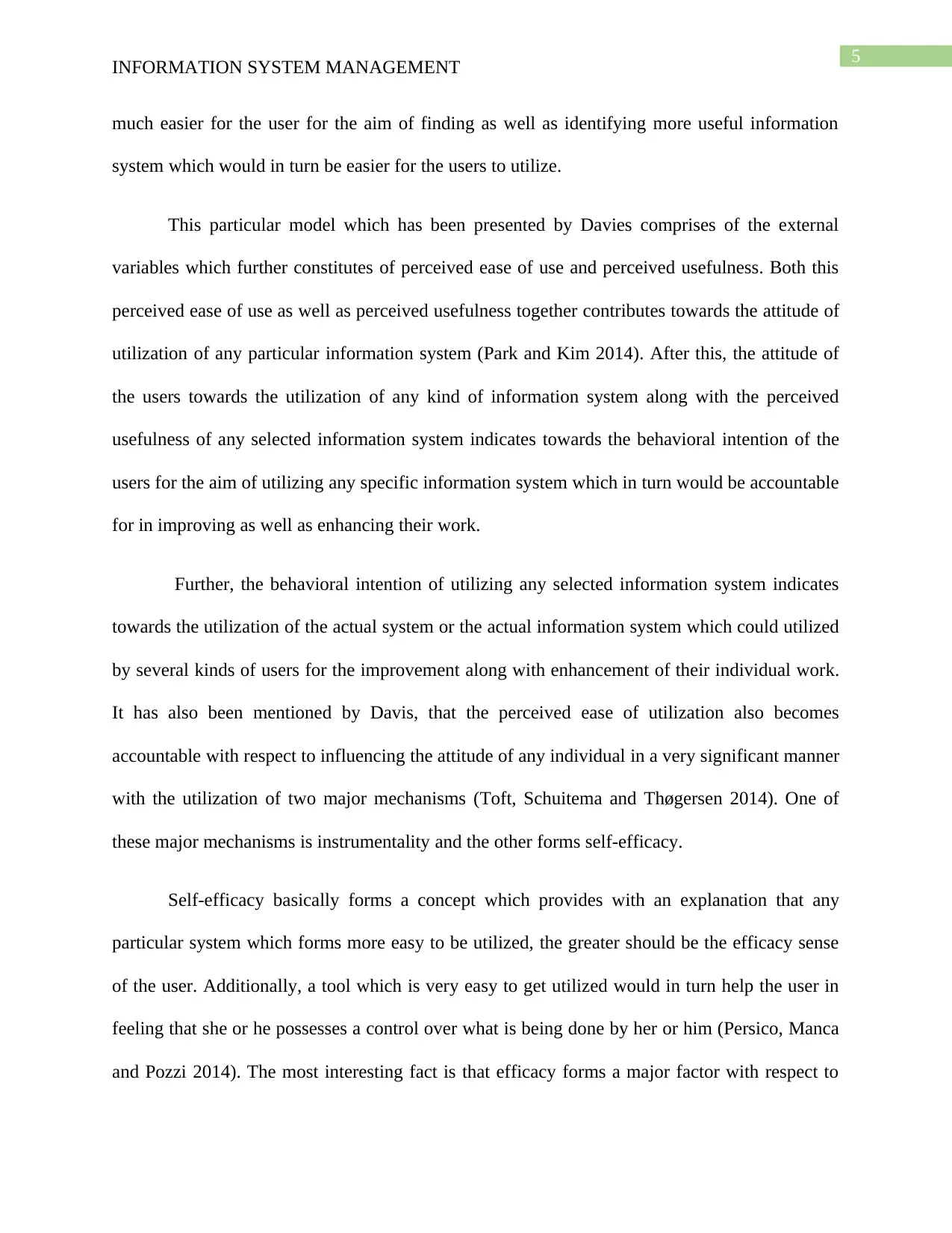
5
INFORMATION SYSTEM MANAGEMENT
much easier for the user for the aim of finding as well as identifying more useful information
system which would in turn be easier for the users to utilize.
This particular model which has been presented by Davies comprises of the external
variables which further constitutes of perceived ease of use and perceived usefulness. Both this
perceived ease of use as well as perceived usefulness together contributes towards the attitude of
utilization of any particular information system (Park and Kim 2014). After this, the attitude of
the users towards the utilization of any kind of information system along with the perceived
usefulness of any selected information system indicates towards the behavioral intention of the
users for the aim of utilizing any specific information system which in turn would be accountable
for in improving as well as enhancing their work.
Further, the behavioral intention of utilizing any selected information system indicates
towards the utilization of the actual system or the actual information system which could utilized
by several kinds of users for the improvement along with enhancement of their individual work.
It has also been mentioned by Davis, that the perceived ease of utilization also becomes
accountable with respect to influencing the attitude of any individual in a very significant manner
with the utilization of two major mechanisms (Toft, Schuitema and Thøgersen 2014). One of
these major mechanisms is instrumentality and the other forms self-efficacy.
Self-efficacy basically forms a concept which provides with an explanation that any
particular system which forms more easy to be utilized, the greater should be the efficacy sense
of the user. Additionally, a tool which is very easy to get utilized would in turn help the user in
feeling that she or he possesses a control over what is being done by her or him (Persico, Manca
and Pozzi 2014). The most interesting fact is that efficacy forms a major factor with respect to
INFORMATION SYSTEM MANAGEMENT
much easier for the user for the aim of finding as well as identifying more useful information
system which would in turn be easier for the users to utilize.
This particular model which has been presented by Davies comprises of the external
variables which further constitutes of perceived ease of use and perceived usefulness. Both this
perceived ease of use as well as perceived usefulness together contributes towards the attitude of
utilization of any particular information system (Park and Kim 2014). After this, the attitude of
the users towards the utilization of any kind of information system along with the perceived
usefulness of any selected information system indicates towards the behavioral intention of the
users for the aim of utilizing any specific information system which in turn would be accountable
for in improving as well as enhancing their work.
Further, the behavioral intention of utilizing any selected information system indicates
towards the utilization of the actual system or the actual information system which could utilized
by several kinds of users for the improvement along with enhancement of their individual work.
It has also been mentioned by Davis, that the perceived ease of utilization also becomes
accountable with respect to influencing the attitude of any individual in a very significant manner
with the utilization of two major mechanisms (Toft, Schuitema and Thøgersen 2014). One of
these major mechanisms is instrumentality and the other forms self-efficacy.
Self-efficacy basically forms a concept which provides with an explanation that any
particular system which forms more easy to be utilized, the greater should be the efficacy sense
of the user. Additionally, a tool which is very easy to get utilized would in turn help the user in
feeling that she or he possesses a control over what is being done by her or him (Persico, Manca
and Pozzi 2014). The most interesting fact is that efficacy forms a major factor with respect to
⊘ This is a preview!⊘
Do you want full access?
Subscribe today to unlock all pages.

Trusted by 1+ million students worldwide
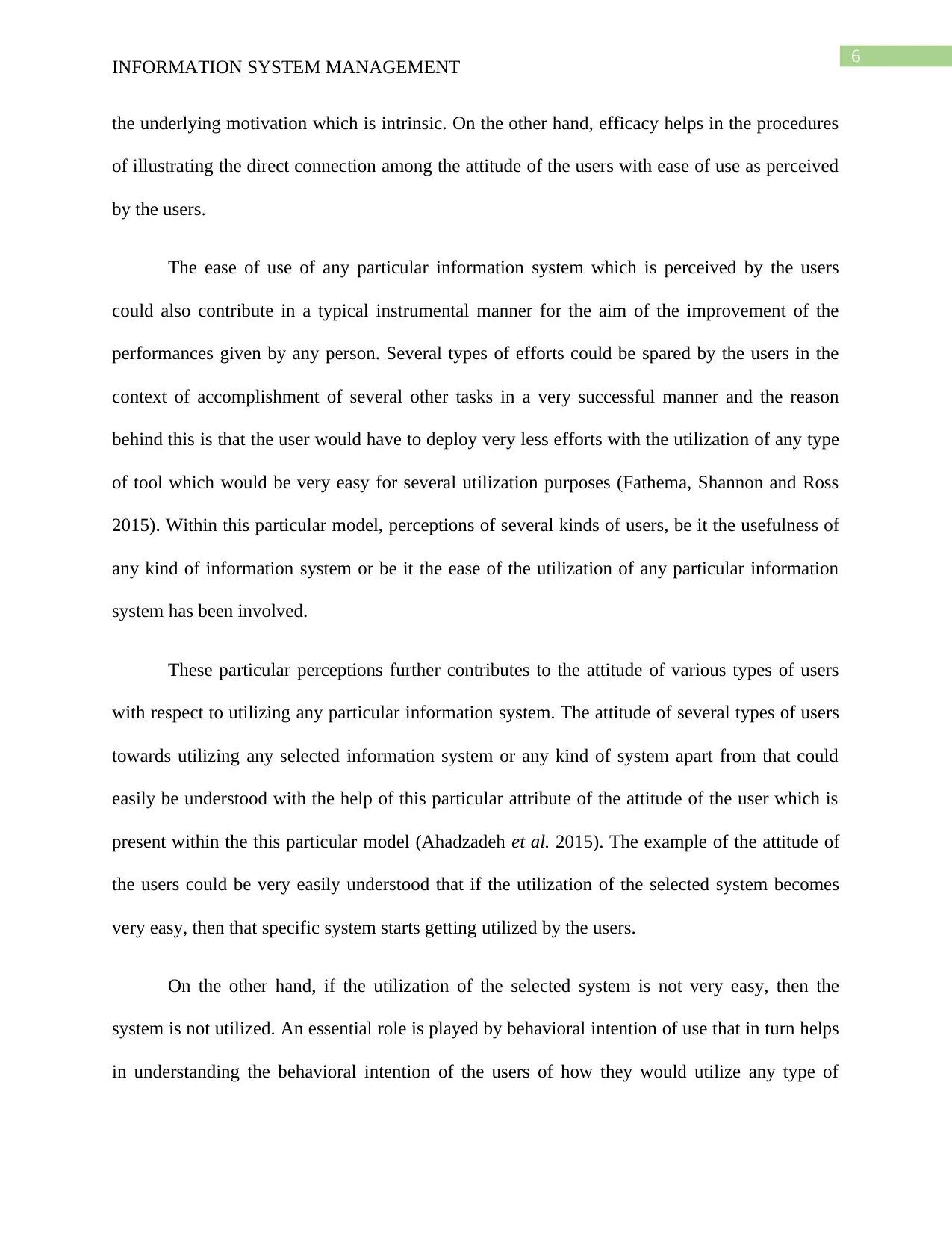
6
INFORMATION SYSTEM MANAGEMENT
the underlying motivation which is intrinsic. On the other hand, efficacy helps in the procedures
of illustrating the direct connection among the attitude of the users with ease of use as perceived
by the users.
The ease of use of any particular information system which is perceived by the users
could also contribute in a typical instrumental manner for the aim of the improvement of the
performances given by any person. Several types of efforts could be spared by the users in the
context of accomplishment of several other tasks in a very successful manner and the reason
behind this is that the user would have to deploy very less efforts with the utilization of any type
of tool which would be very easy for several utilization purposes (Fathema, Shannon and Ross
2015). Within this particular model, perceptions of several kinds of users, be it the usefulness of
any kind of information system or be it the ease of the utilization of any particular information
system has been involved.
These particular perceptions further contributes to the attitude of various types of users
with respect to utilizing any particular information system. The attitude of several types of users
towards utilizing any selected information system or any kind of system apart from that could
easily be understood with the help of this particular attribute of the attitude of the user which is
present within the this particular model (Ahadzadeh et al. 2015). The example of the attitude of
the users could be very easily understood that if the utilization of the selected system becomes
very easy, then that specific system starts getting utilized by the users.
On the other hand, if the utilization of the selected system is not very easy, then the
system is not utilized. An essential role is played by behavioral intention of use that in turn helps
in understanding the behavioral intention of the users of how they would utilize any type of
INFORMATION SYSTEM MANAGEMENT
the underlying motivation which is intrinsic. On the other hand, efficacy helps in the procedures
of illustrating the direct connection among the attitude of the users with ease of use as perceived
by the users.
The ease of use of any particular information system which is perceived by the users
could also contribute in a typical instrumental manner for the aim of the improvement of the
performances given by any person. Several types of efforts could be spared by the users in the
context of accomplishment of several other tasks in a very successful manner and the reason
behind this is that the user would have to deploy very less efforts with the utilization of any type
of tool which would be very easy for several utilization purposes (Fathema, Shannon and Ross
2015). Within this particular model, perceptions of several kinds of users, be it the usefulness of
any kind of information system or be it the ease of the utilization of any particular information
system has been involved.
These particular perceptions further contributes to the attitude of various types of users
with respect to utilizing any particular information system. The attitude of several types of users
towards utilizing any selected information system or any kind of system apart from that could
easily be understood with the help of this particular attribute of the attitude of the user which is
present within the this particular model (Ahadzadeh et al. 2015). The example of the attitude of
the users could be very easily understood that if the utilization of the selected system becomes
very easy, then that specific system starts getting utilized by the users.
On the other hand, if the utilization of the selected system is not very easy, then the
system is not utilized. An essential role is played by behavioral intention of use that in turn helps
in understanding the behavioral intention of the users of how they would utilize any type of
Paraphrase This Document
Need a fresh take? Get an instant paraphrase of this document with our AI Paraphraser
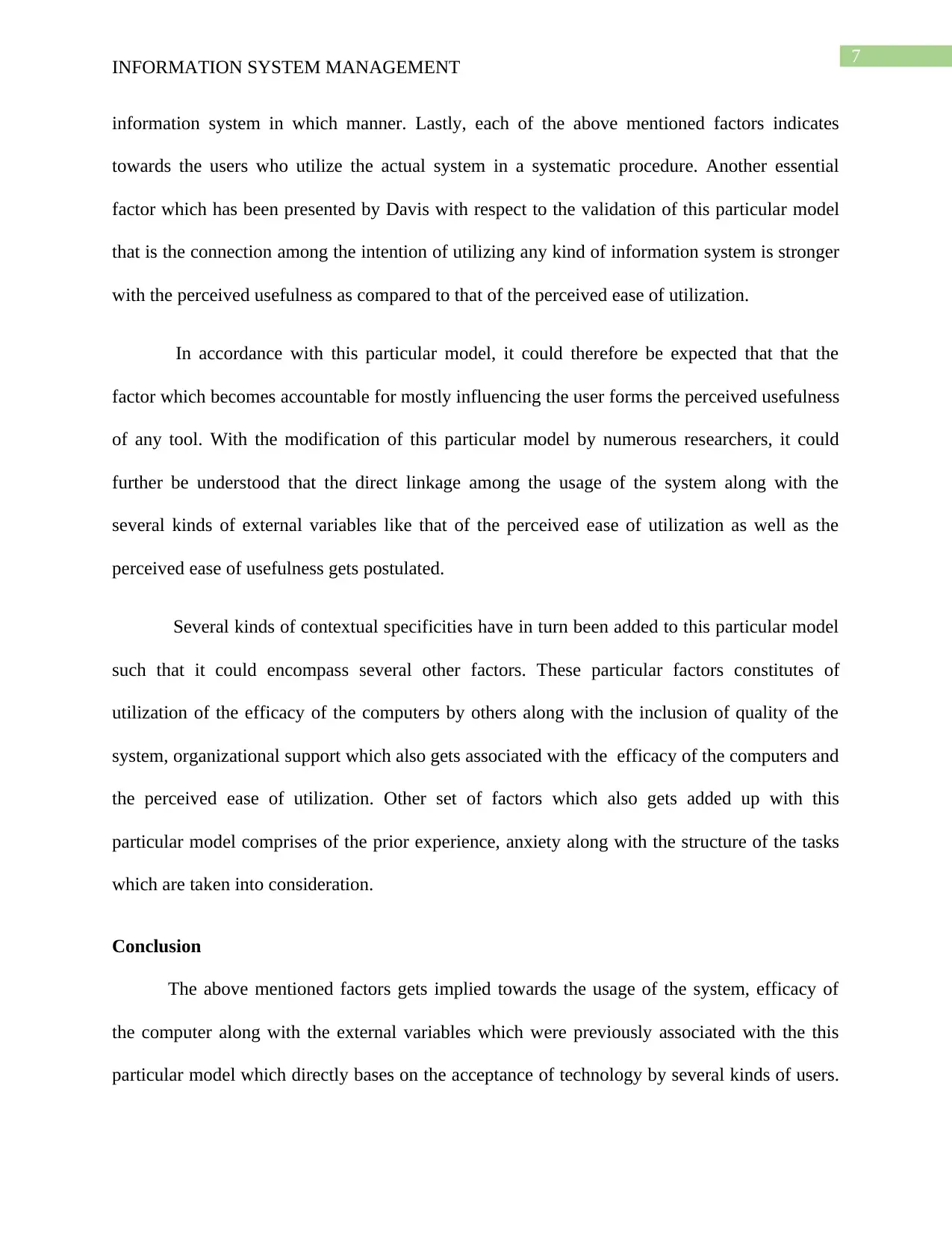
7
INFORMATION SYSTEM MANAGEMENT
information system in which manner. Lastly, each of the above mentioned factors indicates
towards the users who utilize the actual system in a systematic procedure. Another essential
factor which has been presented by Davis with respect to the validation of this particular model
that is the connection among the intention of utilizing any kind of information system is stronger
with the perceived usefulness as compared to that of the perceived ease of utilization.
In accordance with this particular model, it could therefore be expected that that the
factor which becomes accountable for mostly influencing the user forms the perceived usefulness
of any tool. With the modification of this particular model by numerous researchers, it could
further be understood that the direct linkage among the usage of the system along with the
several kinds of external variables like that of the perceived ease of utilization as well as the
perceived ease of usefulness gets postulated.
Several kinds of contextual specificities have in turn been added to this particular model
such that it could encompass several other factors. These particular factors constitutes of
utilization of the efficacy of the computers by others along with the inclusion of quality of the
system, organizational support which also gets associated with the efficacy of the computers and
the perceived ease of utilization. Other set of factors which also gets added up with this
particular model comprises of the prior experience, anxiety along with the structure of the tasks
which are taken into consideration.
Conclusion
The above mentioned factors gets implied towards the usage of the system, efficacy of
the computer along with the external variables which were previously associated with the this
particular model which directly bases on the acceptance of technology by several kinds of users.
INFORMATION SYSTEM MANAGEMENT
information system in which manner. Lastly, each of the above mentioned factors indicates
towards the users who utilize the actual system in a systematic procedure. Another essential
factor which has been presented by Davis with respect to the validation of this particular model
that is the connection among the intention of utilizing any kind of information system is stronger
with the perceived usefulness as compared to that of the perceived ease of utilization.
In accordance with this particular model, it could therefore be expected that that the
factor which becomes accountable for mostly influencing the user forms the perceived usefulness
of any tool. With the modification of this particular model by numerous researchers, it could
further be understood that the direct linkage among the usage of the system along with the
several kinds of external variables like that of the perceived ease of utilization as well as the
perceived ease of usefulness gets postulated.
Several kinds of contextual specificities have in turn been added to this particular model
such that it could encompass several other factors. These particular factors constitutes of
utilization of the efficacy of the computers by others along with the inclusion of quality of the
system, organizational support which also gets associated with the efficacy of the computers and
the perceived ease of utilization. Other set of factors which also gets added up with this
particular model comprises of the prior experience, anxiety along with the structure of the tasks
which are taken into consideration.
Conclusion
The above mentioned factors gets implied towards the usage of the system, efficacy of
the computer along with the external variables which were previously associated with the this
particular model which directly bases on the acceptance of technology by several kinds of users.
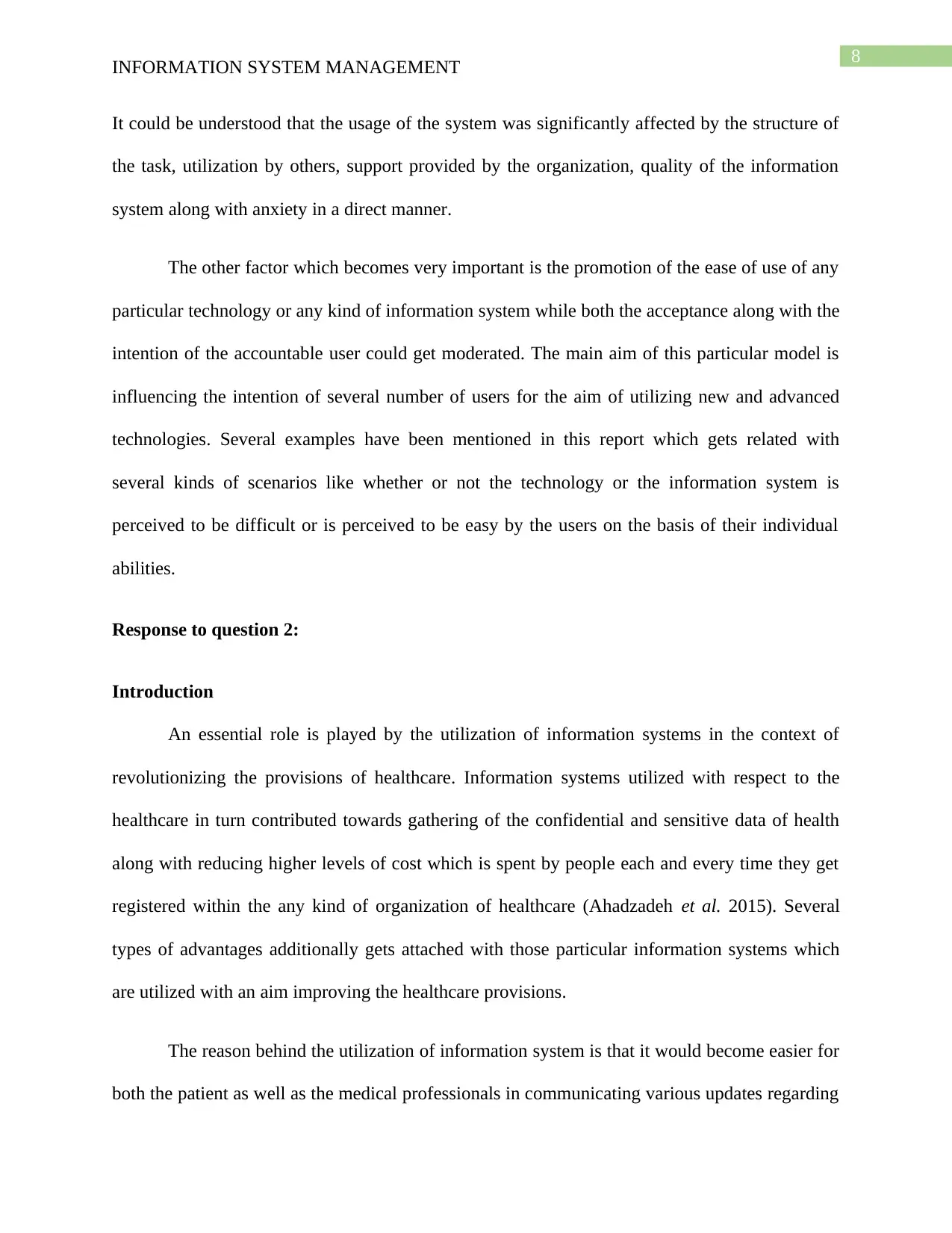
8
INFORMATION SYSTEM MANAGEMENT
It could be understood that the usage of the system was significantly affected by the structure of
the task, utilization by others, support provided by the organization, quality of the information
system along with anxiety in a direct manner.
The other factor which becomes very important is the promotion of the ease of use of any
particular technology or any kind of information system while both the acceptance along with the
intention of the accountable user could get moderated. The main aim of this particular model is
influencing the intention of several number of users for the aim of utilizing new and advanced
technologies. Several examples have been mentioned in this report which gets related with
several kinds of scenarios like whether or not the technology or the information system is
perceived to be difficult or is perceived to be easy by the users on the basis of their individual
abilities.
Response to question 2:
Introduction
An essential role is played by the utilization of information systems in the context of
revolutionizing the provisions of healthcare. Information systems utilized with respect to the
healthcare in turn contributed towards gathering of the confidential and sensitive data of health
along with reducing higher levels of cost which is spent by people each and every time they get
registered within the any kind of organization of healthcare (Ahadzadeh et al. 2015). Several
types of advantages additionally gets attached with those particular information systems which
are utilized with an aim improving the healthcare provisions.
The reason behind the utilization of information system is that it would become easier for
both the patient as well as the medical professionals in communicating various updates regarding
INFORMATION SYSTEM MANAGEMENT
It could be understood that the usage of the system was significantly affected by the structure of
the task, utilization by others, support provided by the organization, quality of the information
system along with anxiety in a direct manner.
The other factor which becomes very important is the promotion of the ease of use of any
particular technology or any kind of information system while both the acceptance along with the
intention of the accountable user could get moderated. The main aim of this particular model is
influencing the intention of several number of users for the aim of utilizing new and advanced
technologies. Several examples have been mentioned in this report which gets related with
several kinds of scenarios like whether or not the technology or the information system is
perceived to be difficult or is perceived to be easy by the users on the basis of their individual
abilities.
Response to question 2:
Introduction
An essential role is played by the utilization of information systems in the context of
revolutionizing the provisions of healthcare. Information systems utilized with respect to the
healthcare in turn contributed towards gathering of the confidential and sensitive data of health
along with reducing higher levels of cost which is spent by people each and every time they get
registered within the any kind of organization of healthcare (Ahadzadeh et al. 2015). Several
types of advantages additionally gets attached with those particular information systems which
are utilized with an aim improving the healthcare provisions.
The reason behind the utilization of information system is that it would become easier for
both the patient as well as the medical professionals in communicating various updates regarding
⊘ This is a preview!⊘
Do you want full access?
Subscribe today to unlock all pages.

Trusted by 1+ million students worldwide
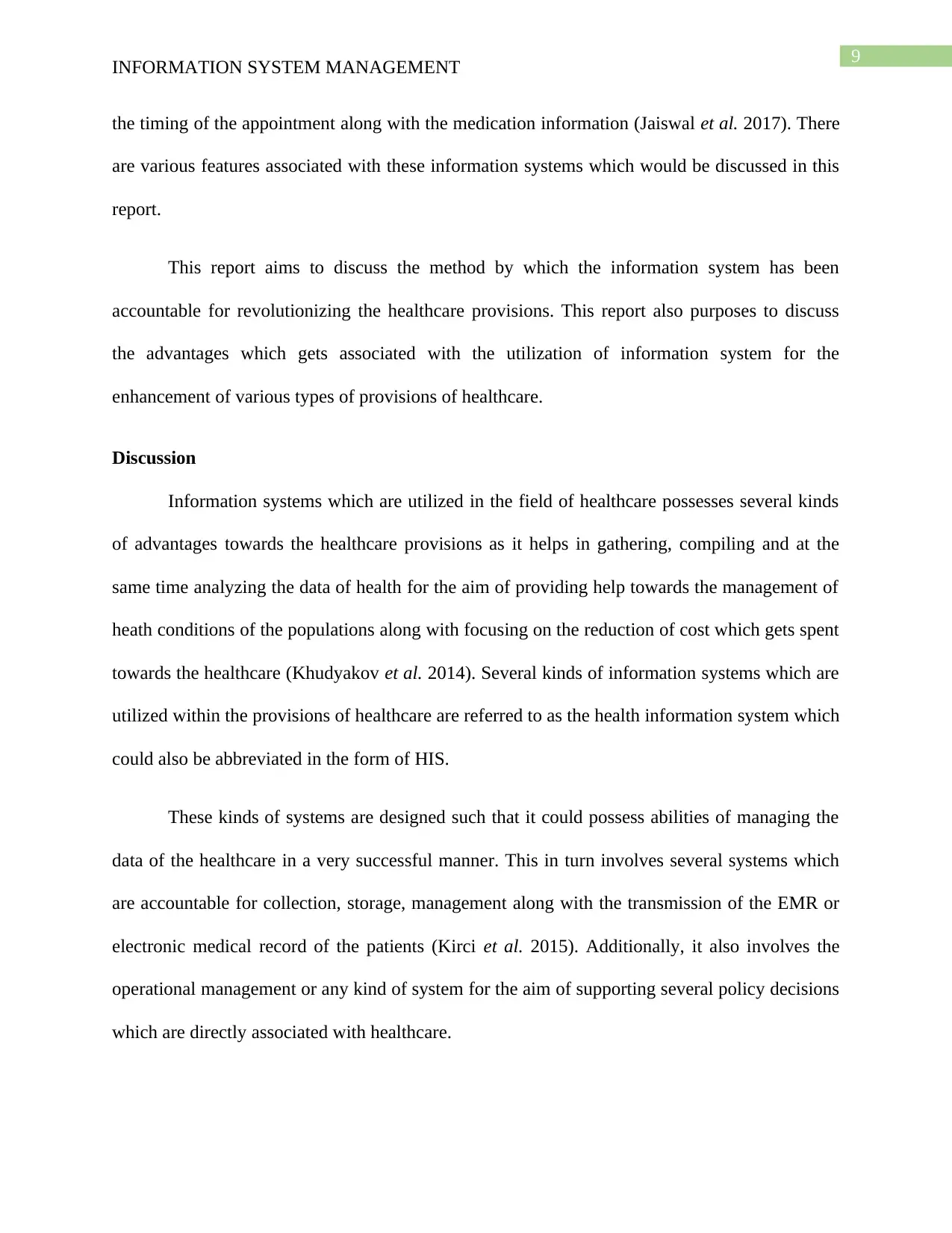
9
INFORMATION SYSTEM MANAGEMENT
the timing of the appointment along with the medication information (Jaiswal et al. 2017). There
are various features associated with these information systems which would be discussed in this
report.
This report aims to discuss the method by which the information system has been
accountable for revolutionizing the healthcare provisions. This report also purposes to discuss
the advantages which gets associated with the utilization of information system for the
enhancement of various types of provisions of healthcare.
Discussion
Information systems which are utilized in the field of healthcare possesses several kinds
of advantages towards the healthcare provisions as it helps in gathering, compiling and at the
same time analyzing the data of health for the aim of providing help towards the management of
heath conditions of the populations along with focusing on the reduction of cost which gets spent
towards the healthcare (Khudyakov et al. 2014). Several kinds of information systems which are
utilized within the provisions of healthcare are referred to as the health information system which
could also be abbreviated in the form of HIS.
These kinds of systems are designed such that it could possess abilities of managing the
data of the healthcare in a very successful manner. This in turn involves several systems which
are accountable for collection, storage, management along with the transmission of the EMR or
electronic medical record of the patients (Kirci et al. 2015). Additionally, it also involves the
operational management or any kind of system for the aim of supporting several policy decisions
which are directly associated with healthcare.
INFORMATION SYSTEM MANAGEMENT
the timing of the appointment along with the medication information (Jaiswal et al. 2017). There
are various features associated with these information systems which would be discussed in this
report.
This report aims to discuss the method by which the information system has been
accountable for revolutionizing the healthcare provisions. This report also purposes to discuss
the advantages which gets associated with the utilization of information system for the
enhancement of various types of provisions of healthcare.
Discussion
Information systems which are utilized in the field of healthcare possesses several kinds
of advantages towards the healthcare provisions as it helps in gathering, compiling and at the
same time analyzing the data of health for the aim of providing help towards the management of
heath conditions of the populations along with focusing on the reduction of cost which gets spent
towards the healthcare (Khudyakov et al. 2014). Several kinds of information systems which are
utilized within the provisions of healthcare are referred to as the health information system which
could also be abbreviated in the form of HIS.
These kinds of systems are designed such that it could possess abilities of managing the
data of the healthcare in a very successful manner. This in turn involves several systems which
are accountable for collection, storage, management along with the transmission of the EMR or
electronic medical record of the patients (Kirci et al. 2015). Additionally, it also involves the
operational management or any kind of system for the aim of supporting several policy decisions
which are directly associated with healthcare.
Paraphrase This Document
Need a fresh take? Get an instant paraphrase of this document with our AI Paraphraser
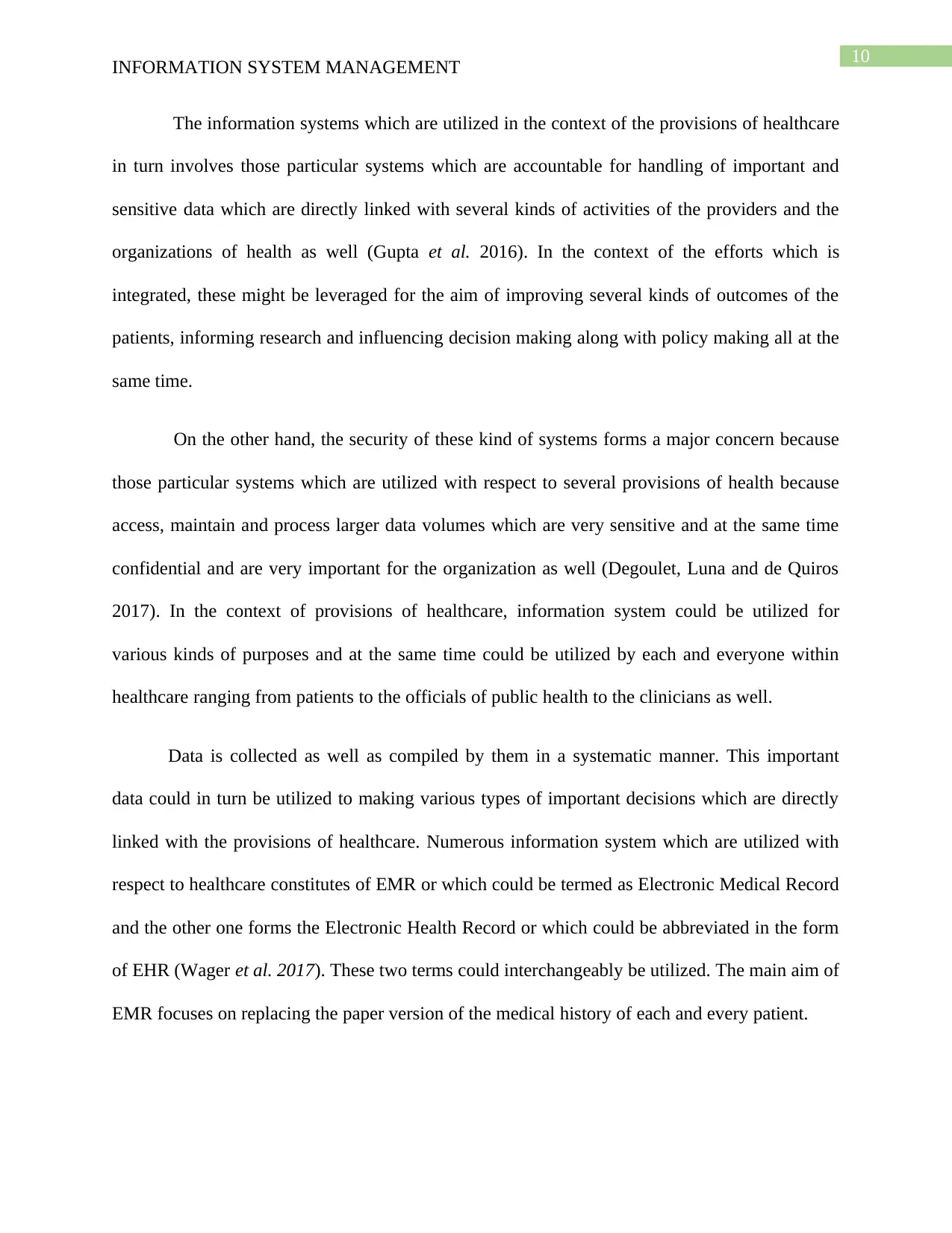
10
INFORMATION SYSTEM MANAGEMENT
The information systems which are utilized in the context of the provisions of healthcare
in turn involves those particular systems which are accountable for handling of important and
sensitive data which are directly linked with several kinds of activities of the providers and the
organizations of health as well (Gupta et al. 2016). In the context of the efforts which is
integrated, these might be leveraged for the aim of improving several kinds of outcomes of the
patients, informing research and influencing decision making along with policy making all at the
same time.
On the other hand, the security of these kind of systems forms a major concern because
those particular systems which are utilized with respect to several provisions of health because
access, maintain and process larger data volumes which are very sensitive and at the same time
confidential and are very important for the organization as well (Degoulet, Luna and de Quiros
2017). In the context of provisions of healthcare, information system could be utilized for
various kinds of purposes and at the same time could be utilized by each and everyone within
healthcare ranging from patients to the officials of public health to the clinicians as well.
Data is collected as well as compiled by them in a systematic manner. This important
data could in turn be utilized to making various types of important decisions which are directly
linked with the provisions of healthcare. Numerous information system which are utilized with
respect to healthcare constitutes of EMR or which could be termed as Electronic Medical Record
and the other one forms the Electronic Health Record or which could be abbreviated in the form
of EHR (Wager et al. 2017). These two terms could interchangeably be utilized. The main aim of
EMR focuses on replacing the paper version of the medical history of each and every patient.
INFORMATION SYSTEM MANAGEMENT
The information systems which are utilized in the context of the provisions of healthcare
in turn involves those particular systems which are accountable for handling of important and
sensitive data which are directly linked with several kinds of activities of the providers and the
organizations of health as well (Gupta et al. 2016). In the context of the efforts which is
integrated, these might be leveraged for the aim of improving several kinds of outcomes of the
patients, informing research and influencing decision making along with policy making all at the
same time.
On the other hand, the security of these kind of systems forms a major concern because
those particular systems which are utilized with respect to several provisions of health because
access, maintain and process larger data volumes which are very sensitive and at the same time
confidential and are very important for the organization as well (Degoulet, Luna and de Quiros
2017). In the context of provisions of healthcare, information system could be utilized for
various kinds of purposes and at the same time could be utilized by each and everyone within
healthcare ranging from patients to the officials of public health to the clinicians as well.
Data is collected as well as compiled by them in a systematic manner. This important
data could in turn be utilized to making various types of important decisions which are directly
linked with the provisions of healthcare. Numerous information system which are utilized with
respect to healthcare constitutes of EMR or which could be termed as Electronic Medical Record
and the other one forms the Electronic Health Record or which could be abbreviated in the form
of EHR (Wager et al. 2017). These two terms could interchangeably be utilized. The main aim of
EMR focuses on replacing the paper version of the medical history of each and every patient.
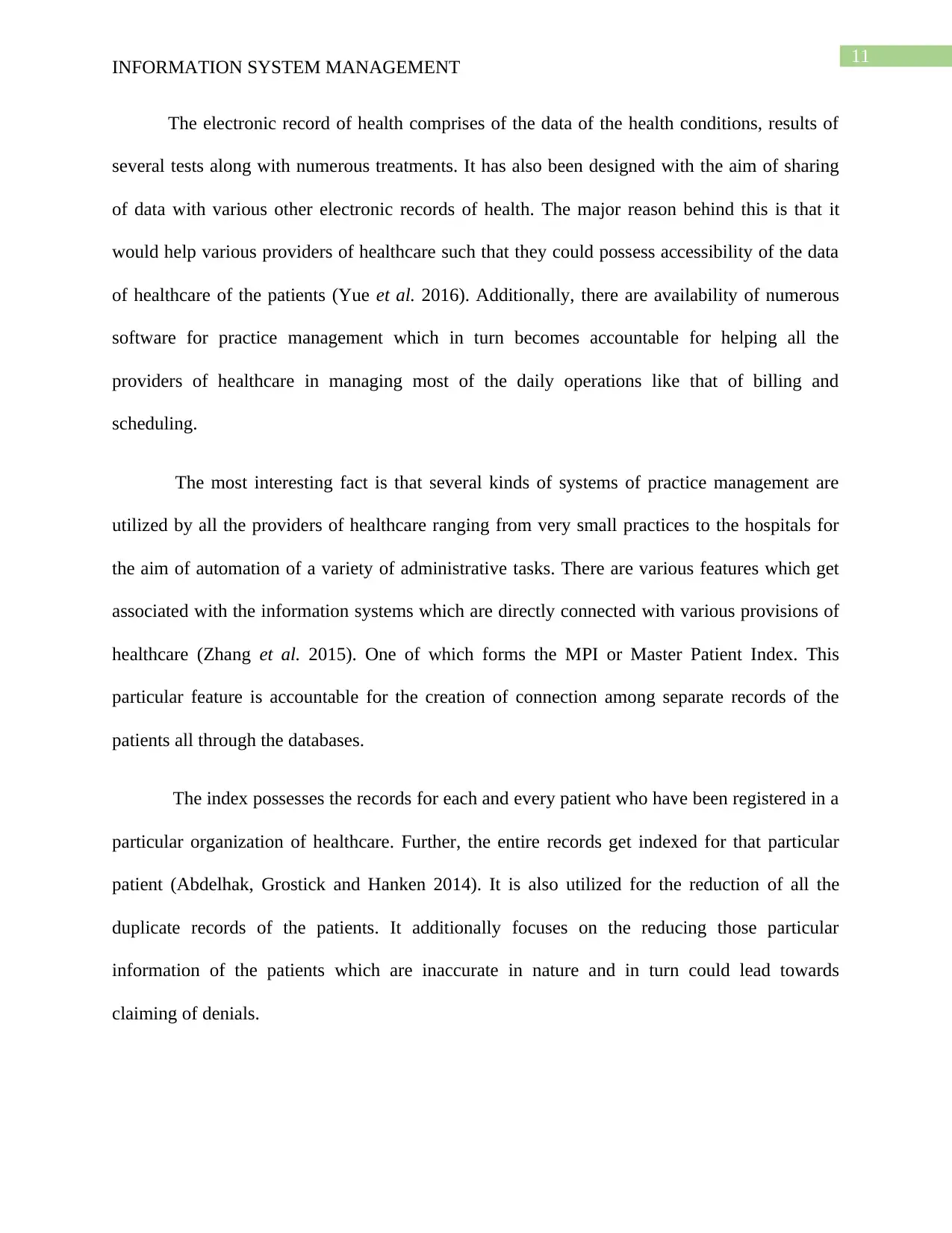
11
INFORMATION SYSTEM MANAGEMENT
The electronic record of health comprises of the data of the health conditions, results of
several tests along with numerous treatments. It has also been designed with the aim of sharing
of data with various other electronic records of health. The major reason behind this is that it
would help various providers of healthcare such that they could possess accessibility of the data
of healthcare of the patients (Yue et al. 2016). Additionally, there are availability of numerous
software for practice management which in turn becomes accountable for helping all the
providers of healthcare in managing most of the daily operations like that of billing and
scheduling.
The most interesting fact is that several kinds of systems of practice management are
utilized by all the providers of healthcare ranging from very small practices to the hospitals for
the aim of automation of a variety of administrative tasks. There are various features which get
associated with the information systems which are directly connected with various provisions of
healthcare (Zhang et al. 2015). One of which forms the MPI or Master Patient Index. This
particular feature is accountable for the creation of connection among separate records of the
patients all through the databases.
The index possesses the records for each and every patient who have been registered in a
particular organization of healthcare. Further, the entire records get indexed for that particular
patient (Abdelhak, Grostick and Hanken 2014). It is also utilized for the reduction of all the
duplicate records of the patients. It additionally focuses on the reducing those particular
information of the patients which are inaccurate in nature and in turn could lead towards
claiming of denials.
INFORMATION SYSTEM MANAGEMENT
The electronic record of health comprises of the data of the health conditions, results of
several tests along with numerous treatments. It has also been designed with the aim of sharing
of data with various other electronic records of health. The major reason behind this is that it
would help various providers of healthcare such that they could possess accessibility of the data
of healthcare of the patients (Yue et al. 2016). Additionally, there are availability of numerous
software for practice management which in turn becomes accountable for helping all the
providers of healthcare in managing most of the daily operations like that of billing and
scheduling.
The most interesting fact is that several kinds of systems of practice management are
utilized by all the providers of healthcare ranging from very small practices to the hospitals for
the aim of automation of a variety of administrative tasks. There are various features which get
associated with the information systems which are directly connected with various provisions of
healthcare (Zhang et al. 2015). One of which forms the MPI or Master Patient Index. This
particular feature is accountable for the creation of connection among separate records of the
patients all through the databases.
The index possesses the records for each and every patient who have been registered in a
particular organization of healthcare. Further, the entire records get indexed for that particular
patient (Abdelhak, Grostick and Hanken 2014). It is also utilized for the reduction of all the
duplicate records of the patients. It additionally focuses on the reducing those particular
information of the patients which are inaccurate in nature and in turn could lead towards
claiming of denials.
⊘ This is a preview!⊘
Do you want full access?
Subscribe today to unlock all pages.

Trusted by 1+ million students worldwide
1 out of 20
Related Documents
Your All-in-One AI-Powered Toolkit for Academic Success.
+13062052269
info@desklib.com
Available 24*7 on WhatsApp / Email
![[object Object]](/_next/static/media/star-bottom.7253800d.svg)
Unlock your academic potential
Copyright © 2020–2025 A2Z Services. All Rights Reserved. Developed and managed by ZUCOL.





